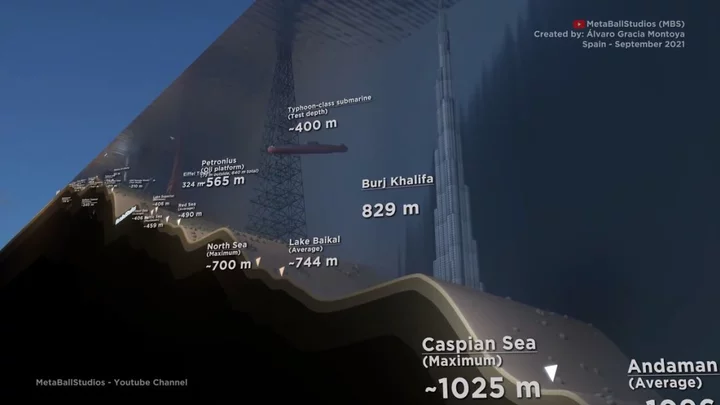
Eerie clip showing just how deep the ocean is has left people with the creeps
A graphic video showing just how deep the ocean really goes is giving people the creeps. Posted on YouTube by MetaBall Studios, the video keeps going down and down in the water, to the likes of the Titanic wreck (which sits at 3700m below the surface), and even the level at which Mount Everest would be completely drowned. However, it has nothing on the Pacific Ocean's Challenger Deep (the deepest part of the ocean), which is around 11,000m down. Scary stuff. Click here to sign up for our newsletters
1970-01-01 08:00
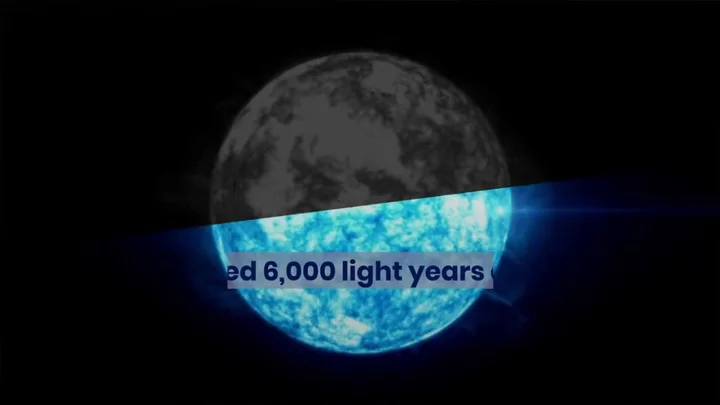
Strange structures pointing towards black hole discovered in space
There’s been another unexpected discovery in our galaxy, after scientists observed strange structures pointing towards a black hole. These “dashes” were spotted in the Milky Way and all aim towards the black hole at its centre. The sheer number of these structures is unprecedented, too, with hundreds of them measuring five to 10 light-years long discovered as part of the new research. The true nature of the dashes remains a mystery, and there’s currently no explanation as to how they got there in the first place. Sign up to our free Indy100 weekly newsletter “It was a surprise to suddenly find a new population of structures that seem to be pointing in the direction of the black hole,” Northwestern University’s Farhad Yusef-Zadeh, who led the research. “I was actually stunned when I saw these. We had to do a lot of work to establish that we weren’t fooling ourselves. And we found that these filaments are not random but appear to be tied to the outflow of our black hole. “By studying them, we could learn more about the black hole’s spin and accretion disk orientation. It is satisfying when one finds order in a middle of a chaotic field of the nucleus of our galaxy.” The research, published in The Astrophysical Journal Letters, also reflects on findings from Professor Yusef-Zadeh in the early 80s, who discovered one-dimensional filaments near the black hole in the middle of the Milky Way, named Sagittarius A*. The new structures are spread out in a different direction, and change the way scientists have been thinking about filaments like this completely. “We have always been thinking about vertical filaments and their origin,” he said. “I’m used to them being vertical. I never considered there might be others along the plane.” Have your say in our news democracy. Click the upvote icon at the top of the page to help raise this article through the indy100 rankings.
1970-01-01 08:00

Scientists baffled by discovery of '2000-year-old computer'
Scientists have been left baffled by the discovery of the wreck of a 2,000-year-old “computer” that is amazingly complex. The Antikythera mechanism – an astronomical calendar – has been dubbed “‘the first computer” and has baffled scientists for generations after it was first discovered inside a Greek shipwreck in 1901. The device is a hand-powered time-keeping instrument that used a wing-up system to track the sun, moon and planets’ celestial time. It also worked as a calendar, tracking the phases of the Moon and the timing of eclipses. Despite sounding relatively simple, the mechanism was actually ahead of its time, being more technically sophisticated than any other tool that was invented over the next 1,000 years. In its current condition, the mechanism is in 82 separate fragments with only a third of its original structure remaining, including 30 corroded bronze gearwheels. Sign up to our free Indy100 weekly newsletter Research into the device from experts at University College London involved 3D computer modelling and helped them solve the mystery of how the device worked, revealing a “creation of genius”. Adam Wojcik, a materials scientist at UCL said at the time: “We believe that our reconstruction fits all the evidence that scientists have gleaned from the extant remains to date.” They theorised that the device tracked the movement of the sun, moon and planets on concentric rings, as the ancient Greeks believed that the sun and planets revolved around Earth, rather than the sun. The researchers explained in Scientific Reports: “Solving this complex 3D puzzle reveals a creation of genius—combining cycles from Babylonian astronomy, mathematics from Plato’s Academy and ancient Greek astronomical theories.” Have your say in our news democracy. Click the upvote icon at the top of the page to help raise this article through the indy100 rankings.
1970-01-01 08:00
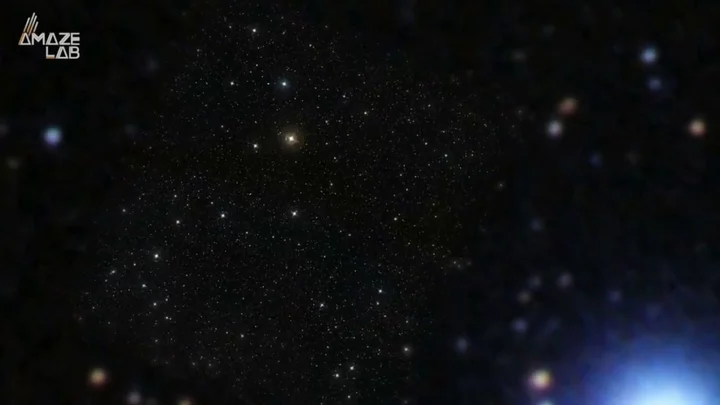
Scientists discover that the universe is evaporating right in front of our eyes
Every now and then a story comes along which completely changes the way you think about space. For instance, did you know the universe is essentially evaporating right before our eyes? A new study has been released which focuses on the effect that radiation emitted from objects in the solar system can have a massive impact on quantum fields surrounding them. It follows on from Stephen Hawking’s theory that black holes lose mass and evaporate over time as an unusual form of radiation takes effect. Now, astrophysicists Michael Wondrak, Walter van Suijlekom, and Heino Falcke of Radboud University in the Netherlands have stated that this unusual form of radiation is apparent in other objects as well as black holes. Sign up to our free Indy100 weekly newsletter In fact, they believe that “Hawking radiation” could be found in objects apparent everywhere in the universe – and it could mean that the universe is slowly evaporating before our very eyes. "We demonstrate that," Wondrak says in the study published in Physical Review Letters. "In addition to the well-known Hawking radiation, there is also a new form of radiation." "We show that far beyond a black hole the curvature of space-time plays a big role in creating radiation," van Suijlekom explains. "The particles are already separated there by the tidal forces of the gravitational field." Essentially, huge objects in the solar system can cause space-time to bend around them. When that happens, it causes enough change in quantum fields to generate particles which have similar properties to Hawking radiation. Falcke said: "That means that objects without an event horizon, such as the remnants of dead stars and other large objects in the universe, also have this sort of radiation. "And, after a very long period, that would lead to everything in the universe eventually evaporating, just like black holes. This changes not only our understanding of Hawking radiation but also our view of the universe and its future." Have your say in our news democracy. Click the upvote icon at the top of the page to help raise this article through the indy100 rankings.
1970-01-01 08:00

Scientists make 'shocking' discovery that life could be hiding on Saturn's moon
Dramatic explosions on the surface of one of Saturn's moons have been observed, and it could change the way scientists approach the search for life in the universe. Saturn's ice-covered moon Enceladus has been the subject of attention from astronomers for decades after plumes of water vapor were observed erupting from its surface 20 years ago by the Cassini spacecraft. Now, the biggest plume yet has been spotted by the James Webb Space Telescope and it measures a massive 10,000 kilometers in length. Incredibly, the plume emitting from the geyser on the surface measures 20 times the size of the moon itself, and it indicates that there’s more to Enceladus than previously thought. Sign up to our free Indy100 weekly newsletter Planetary scientist Geronimo Villanueva of NASA's Goddard Space Flight Center said: "When I was looking at the data, at first, I was thinking I had to be wrong, it was just so shocking to map a plume more than 20 times the diameter of the moon. "The plume extends far beyond what we could have imagined." Instead of solid ice, the size of the plume shows us that there’s a liquid ocean under the surface. It’s kept warm enough to avoid freezing due to the movement that results from the gravitational pull of Saturn. As ever, the existence of liquid water suggests that there’s the possibility of life existing there, and it's encouraging news for authors of the study accepted in Nature Astronomy. "The orbit of Enceladus around Saturn is relatively quick, just 33 hours. As it whips around Saturn, the moon and its jets are basically spitting off water, leaving a halo, almost like a donut, in its wake," Villanueva said. "In the Webb observations, not only was the plume huge, but there was just water absolutely everywhere." It remains one of the most interesting bodies being studied in the solar system, as geochemist Christopher Glein of the Southwest Research Institute. “Enceladus is one of the most dynamic objects in the Solar System and is a prime target in humanity's search for life beyond Earth," geochemist Christopher Glein of the Southwest Research Institute said. "In the years since NASA's Cassini spacecraft first looked at Enceladus, we never cease to be amazed by what we find is happening on this extraordinary moon." Have your say in our news democracy. Click the upvote icon at the top of the page to help raise this article through the indy100 rankings.
1970-01-01 08:00

Ex-Google officer gives stark warning about how AI will evolve in 'months'
An ex-Google officer has shared a warning of the 'danger' AI could pose within 'months' if it keeps growing at the rate it has. Mo Gawdat appeared on Steven Bartlett's Diary of a CEO, where he warned that AI machines have 'emotions' and are allegedly far more 'sentient' than we initially thought. "If we define being sentient as engaging in life with free will and a sense of awareness... then AI is sentient in every possible way", he said. Click here to sign up for our newsletters
1970-01-01 08:00
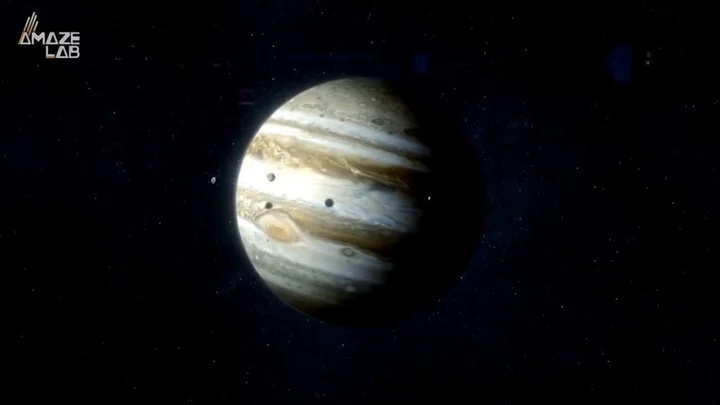
Scientists make 'shocking' discovery on Saturn's moon that could reveal signs of life
Dramatic explosions on the surface of one of Saturn's moons have been observed, and it could change the way scientists approach the search for life in the universe. Saturn's ice-covered moon Enceladus has been the subject of attention from astronomers for decades after plumes of water vapor were observed erupting from its surface 20 years ago by the Cassini spacecraft. Now, the biggest plume yet has been spotted by the James Webb Space Telescope and it measures a massive 10,000 kilometers in length. Incredibly, the plume emitting from the geyser on the surface measures 20 times the size of the moon itself, and it indicates that there’s more to Enceladus than previously thought. Sign up to our free Indy100 weekly newsletter Planetary scientist Geronimo Villanueva of NASA's Goddard Space Flight Center said: "When I was looking at the data, at first, I was thinking I had to be wrong, it was just so shocking to map a plume more than 20 times the diameter of the moon. "The plume extends far beyond what we could have imagined." Instead of solid ice, the size of the plume shows us that there’s a liquid ocean under the surface. It’s kept warm enough to avoid freezing due to the movement that results from the gravitational pull of Saturn. As ever, the existence of liquid water suggests that there’s the possibility of life existing there, and it's encouraging news for authors of the study accepted in Nature Astronomy. "The orbit of Enceladus around Saturn is relatively quick, just 33 hours. As it whips around Saturn, the moon and its jets are basically spitting off water, leaving a halo, almost like a donut, in its wake," Villanueva said. "In the Webb observations, not only was the plume huge, but there was just water absolutely everywhere." It remains one of the most interesting bodies being studied in the solar system, as geochemist Christopher Glein of the Southwest Research Institute. “Enceladus is one of the most dynamic objects in the Solar System and is a prime target in humanity's search for life beyond Earth," geochemist Christopher Glein of the Southwest Research Institute said. "In the years since NASA's Cassini spacecraft first looked at Enceladus, we never cease to be amazed by what we find is happening on this extraordinary moon." Have your say in our news democracy. Click the upvote icon at the top of the page to help raise this article through the indy100 rankings.
1970-01-01 08:00

Scientists discover secret 'mega-city' underground while studying ants
Scientists who were attempting to map an abandoned ant hill didn't expect to find a mega-city when they shot the hill full of cement, but that's exactly what they discovered. Over three days, scientists pumped 10 tons of cement into the empty ant hill to map its networks. After the cement dried, they dug for weeks around it. Sign up to our free Indy100 weekly newsletter The excavation revealed an incredibly impressive, intricate, and bizarre ant mega-city. The mega-city was a truly colossal undertaking. A video revealed that the ants created the structure by displacing 40 tons of dirt. And it really is a mega-city. The ants networked to disposal pits and fungus gardens. Each tunnel was designed to ensure thorough ventilation and reduce transport time. The narrator disclosed the truth. That despite the complex nature of the mega-city, there was no single architect of any - but it was down to the collective will of the colony. "Everything looks like it has been designed by an architect a single mind but of course, that isn’t true," they said. "This colossal and complex city was created by the collective will of the ant colony, the super organism." The short resurfaced clip is from a much longer piece called Ants! Nature’s Secret Power. You can watch the full documentary here. Our city designers should take a few notes. Have your say in our news democracy. Click the upvote icon at the top of the page to help raise this article through the indy100 rankings.
1970-01-01 08:00
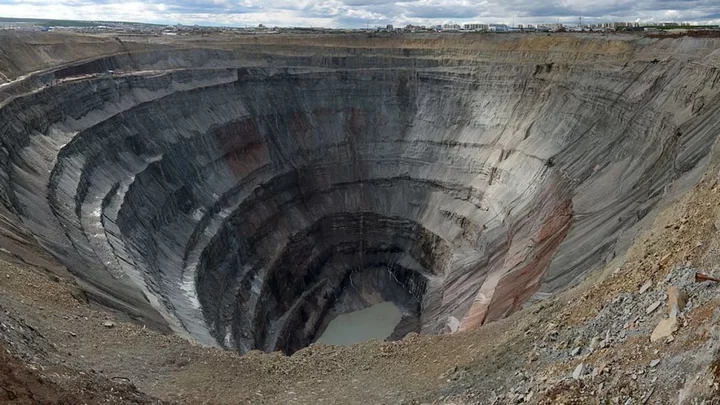
China is digging one of the deepest ever holes and might find signs of life
China have embarked on an enormous project: to dig the biggest hole in the country. The planned 10,000 metre hole will aim to pierce through ten layers of rock and could even end up finding signs of life as suggested by discoveries in past boreholes. And the objective? To reach rocks and minerals that could date back to around 145 million years ago - or the Cretaceous period. Findings from the mission may help alert China to environmental hazards such as volcanoes and earthquakes, whilst also identifying potentially valuable minerals lurking below. Past expeditions have also unearthed signs of life - with one project discovering signs of life under the surface. Don't worry, it wasn't subterranean humans or any other horror movie tropes. That borehole unearthed plankton 4 miles below the surface. Sign up to our free Indy100 weekly newsletter That project won't be surpassed by this new - admittedly massive - attempt. The deepest ever dug - the one that discovered the plankton - was in Russia. The Kola Superdeep Borehole - just a really big hole in the ground - ended up reaching over 11,000 meters below sea level after being started by Soviet scientists in 1970. They had to abandon the project after hitting extremely high temperatures that they weren't expecting. Interesting. The Chinese project isn't going to be easy. It's not as simple as digging straight down into the Earth's crust and hoping for the best. It's also extremely costly and time-consuming. “The construction difficulty of the drilling project can be compared to a big truck driving on two thin steel cables,” Sun Jinsheng, an academic from the Chinese Academy of Engineering, told news agency Xinhua. So yeah, they'll need more than a JCB for this. Have your say in our news democracy. Click the upvote icon at the top of the page to help raise this article through the indy100 rankings.
1970-01-01 08:00

AI can now show you new angles on your favourite memes
Rarely a day goes by at the moment without another breakthrough in artificial intelligence that seemingly fascinates and horrifies us in equal measure. The newest trend around AI involves the expansion of pre-existing pictures to show what the wider surroundings of the image would have looked like. While that doesn't sound particularly controversial it did manage to spark a debate when creators started using the tool to imagine what the surroundings of famous paintings like the Mona Lisa would have looked like. Sign up to our free Indy100 weekly newsletter That was already considered controversial enough, as tampering with famous masterworks is big no-no, how would the internet feel when AI starts messing with their beloved memes? AI educator and designer Linus Ekenstam decided to test this by checking what AI thought was going on behind-the-scenes of some of the most popular memes ever. Using Generative Fill, the new Photoshop AI he took a look at memes like 'distracted boyfriend' and 'Hide the pain Harold' and these are the results. Other memes that Ekenstam looked at included the 'Change my mind' memes and the 'Woman yelling at a cat' meme. The debate around AI continues to linger on with some individuals experimenting with it in new and complex ways. One developer claims that he managed to 'clone' his girlfriend using ChatGPT. Meanwhile, musician Grimes, who has previously championed the technology is now claiming that it poses an "extinction risk." Have your say in our news democracy. Click the upvote icon at the top of the page to help raise this article through the indy100 rankings.
1970-01-01 08:00
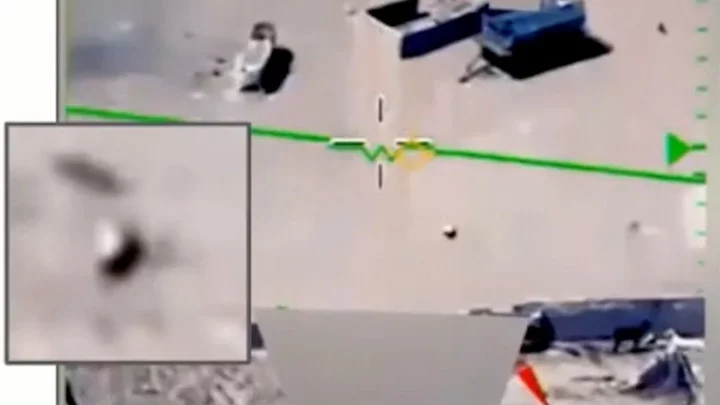
Nasa baffled by eerie new footage of 'UFO' flying over desert in Middle East
Nasa have released eerie footage of a mysterious orb flying over a Middle Eastern desert - and they're yet to work out what it is. Dr Sean Kirkpatrick, the director of the Pentagon's All-Domain Anomaly Resolution Office, who were commissioned by the space agency, shared the findings of their 2022 project yesterday (31 May), including the UFO. "This is a typical example of a thing we see most of", he began, before revealing the object had 'no enigmatic technical capabilities'. "Being able to come to some conclusion is going to take time until we can get better resolved data on similar objects", he added. Click here to sign up for our newsletters
1970-01-01 08:00

It is possible to survive the 'euthanasia roller coaster' says the man who designed it
Roller coasters are synonymous with a fun and exhilarating time at a theme park - but one artist has designed an "Euthanasia Coaster" that is specifically intended to kill its passengers. Julijonas Urbonasis is the man behind the 2010 project which has been described as a thought experiment or conceptual art. The "hypothetic death machine in the form of a roller coaster, engineered to humanely – with elegance and euphoria – take the life of a human being," according to his website. Sign up to our free Indy100 weekly newsletter How it works is that the sheer speed of the roller coaster along with number of loops would result in "oxygen deficiency in the brain," which would ultimately kill those who are on board the ride. So it appears, there's no chance of surviving the ride if you're on it. @criminologyandcoffee Would you ride the Euthanasia Coaster? #euthanasiacoaster #julijonasurbonas #rollercoaster However, there may be a way, according to Urbonas - with the Lithuanian artist explaining that it requires sporting some anti-gravity gear. "A possible usage is the 'hacked' thrill ride, which was suggested to me by an aeronautic engineer who happened to visit the coaster's scale model during an exhibition," he told LadBible back in 2021. "She said, 'Your machine could be hacked, you know.' "After my confusion, she explained, 'Using anti-g trousers that prevent pilots from blackout and fainting, I believe I would survive the ride and turn it into the most extreme thrill ride.'" While a scale model of the ride was built, according to Snopes but building the roller coaster in real life is not the aim for Urbonas - instead, the purpose of the design is "to convince the public that it can be built." "I have quite the list of people who would like to be scientific objects if the project would advance towards realisation. Most of them are elderly from the US. But I don’t want to go this far," Urbonas said in a 2018 interview with Arterritory Have your say in our news democracy. Click the upvote icon at the top of the page to help raise this article through the indy100 rankings.
1970-01-01 08:00
